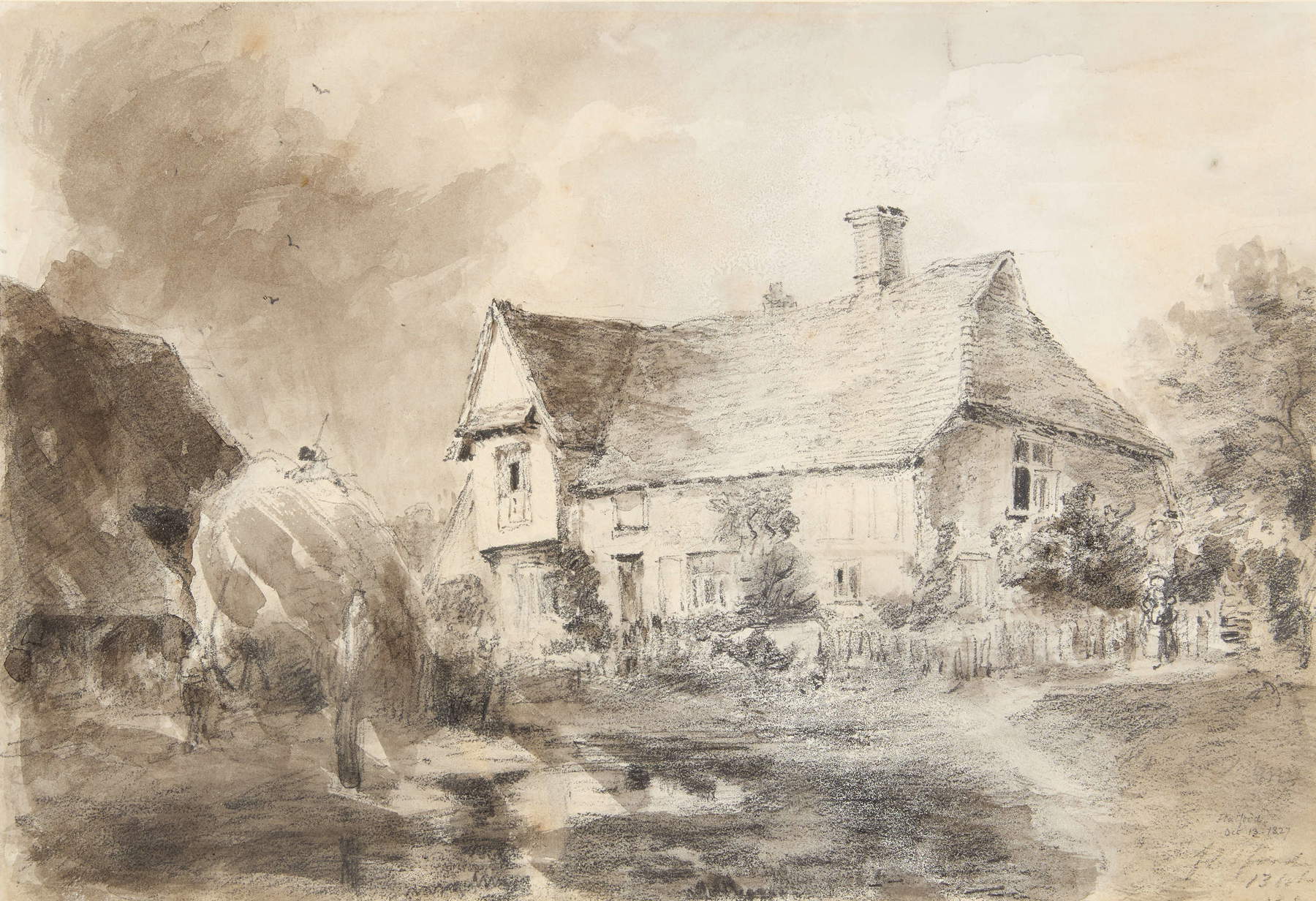A drawing of extraordinary historical and artistic interest by John Constable (East Bergholt, 1776-London, 1837), among the greatest masters of English landscape painting, is re-emerging on the market after nearly two centuries of absence. The work, titledA House and Haystack at Flatford, will be the centerpiece of the Old Master, British & European Pictures auction organized by Roseberys London on Nov. 12, 2025. Estimated at between £20,000 and £30 ,000 (€22-34,000), this drawing represents one of the very rare direct evidence of Constable’s graphic production remaining in private hands.
Executed in 1827 and signed and dated “Flatford / 13 Oct / 1827” in the lower right corner, the composition depicts Valley Farm, a 15th-century half-timbered house located near Flatford Mill in the Suffolk countryside. The image captures with extraordinary immediacy the stillness of an autumn afternoon: the house, bathed in the soft, diffuse light typical of English skies, is flanked by a large sheaf of hay, a symbol of the rural life that inspired all of the painter’s poetry.

The paper bears a provenance story as straightforward as it is valuable. John Constable gave it to his second son, Charles Golding Constable, as evidenced by a coeval inscription. After Charles’ death in 1878, the drawing passed into the hands of James Henry Beazley, a family friend, at the behest of his widow Anna Maria Constable (née Blundell). Pasted on the verso is an annotation by Beazley that reads, “This sketch was given to the late James Beazley by Constable’s widow or relative, in gratitude for a small service rendered by him.”
Since then, the drawing has remained in the same lineage, discreetly guarded for nearly two centuries. This is thus the first public appearance of the work since its execution, a fact that gives the auction an exceptional character.
Flatford, a small village in the Stour River Valley, occupies a central place in John Constable’s imagination. Here his father, Golding Constable, owned a mill that would later pass to his younger brother Abram. Although the painter’s career took place primarily in London, the artist never ceased to return to his native Dedham Vale, finding the Suffolk countryside the inexhaustible source of his inspiration.
Many of his most famous works are set around Flatford Mill. The Valley Farm depicted in the drawing, once the home of wealthy farmers, also appears in the famous painting of the same name now at the Tate Britain. A House and Haystack at Flatford can thus be read as a preparatory fragment or as a poetic memory of those places that deeply marked Constable’s artistic vision.
According to studies by cataloger Graham Reynolds, the sheet belongs to a notebook made on Whatman paper from 1824, of which other pages scattered in museums and private collections are known. Constable used these notebooks during his sojourns in Flatford to jot down direct impressions from life: glimpses of rivers, trees, clouds, and rural architecture.
The mixed technique employed (chalk and watercolor) reveals an intention to quickly capture atmospheric variations, the true focus of his poetics. Indeed, the artist considered the sky and light not as mere backgrounds, but as emotional protagonists of the landscape. In this small sheet, the freshness of execution and the confidence of the stroke restore the immediacy of a gaze deeply connected to nature.
John Constable, a member of the Royal Academy, was among the first to ennoble the English landscape by elevating it to an autonomous artistic subject, free of mythological or historical references. His interest in optical truth and real weather conditions profoundly influenced nineteenth-century European painting, paving the way for the sensibility of the Impressionists.
Unlike his contemporary Turner, who tended toward luministic dramatization, Constable preferred the intimate truth of nature, the everydayness of familiar places, the poetry of the man-made countryside. His art, built on direct observation and affective memory, anticipates a modern idea of landscape as lived and personal space.
The appearance of A House and Haystack at Flatford on the art market is thus an event that represents the re-emergence of an authentic page from Constable’s visual diary, a witness to his constant search for harmony between nature and feeling. The Roseberys London auction offers scholars and collectors an opportunity to reconsider the importance of drawings as a creative tool in Constable’s oeuvre. These sheets, often made outdoors and later used as references for paintings, provide the key to understanding his revolutionary vision of landscape.
Lara L’vov-Basirov, associate director and head of the Department of Old Art, British and European Images at Roseberys, said, “This wonderfully expressive drawing offers an intimate look at the Suffolk countryside that shaped Constable’s aesthetic imagination. The provenance, which comes directly from the artist, represents a tangible link to his life and work.”
 |
| England, a rare and unpublished drawing by John Constable pops up: it will go to auction |
Warning: the translation into English of the original Italian article was created using automatic tools. We undertake to review all articles, but we do not guarantee the total absence of inaccuracies in the translation due to the program. You can find the original by clicking on the ITA button. If you find any mistake,please contact us.